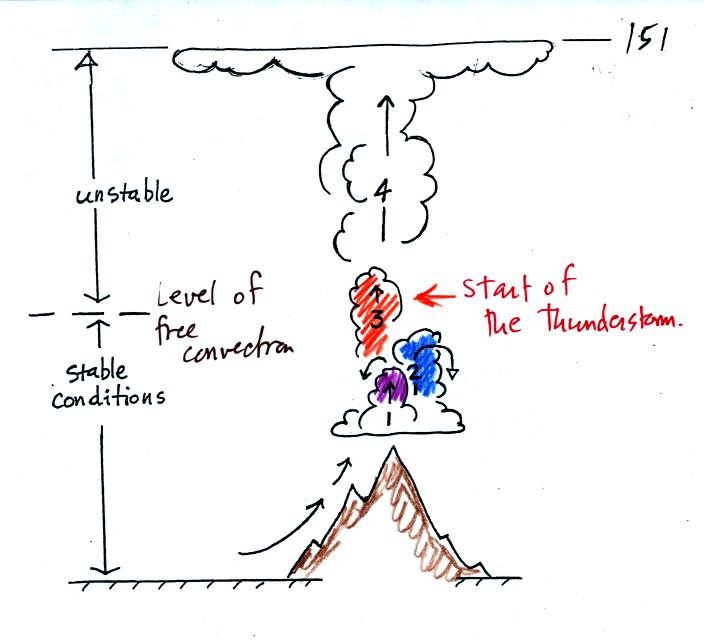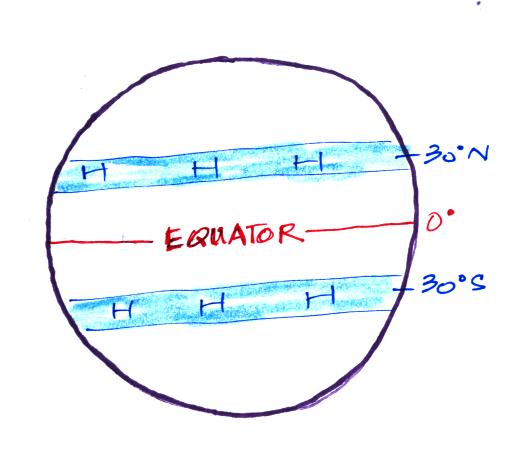
Among other things, the
3-cell
model predicts belts of high pressure (the subtropical high
pressure belts) at 30 N and 30 S
latitude. If you remove the assumption
that the earth is of uniform
composition,
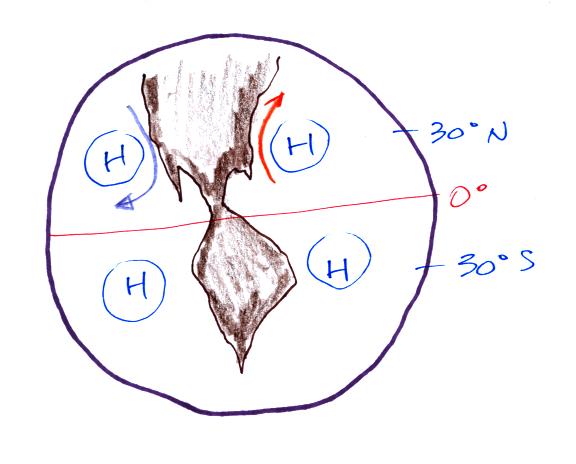
You find circular centers of high
pressure instead of belts
of high pressure. The Bermuda high and the Gulf Stream
are shown above off the E Coast of
the US in the picture above. The Pacific High and the
California current are found off the W Coast.
If you remove the assumption that the earth isn't tilted
(toward or away from the sun) all that happens is that the
features above move a little north or
south depending on the time of year. That
has a big effect on weather in the desert SW and along the W
Coast.
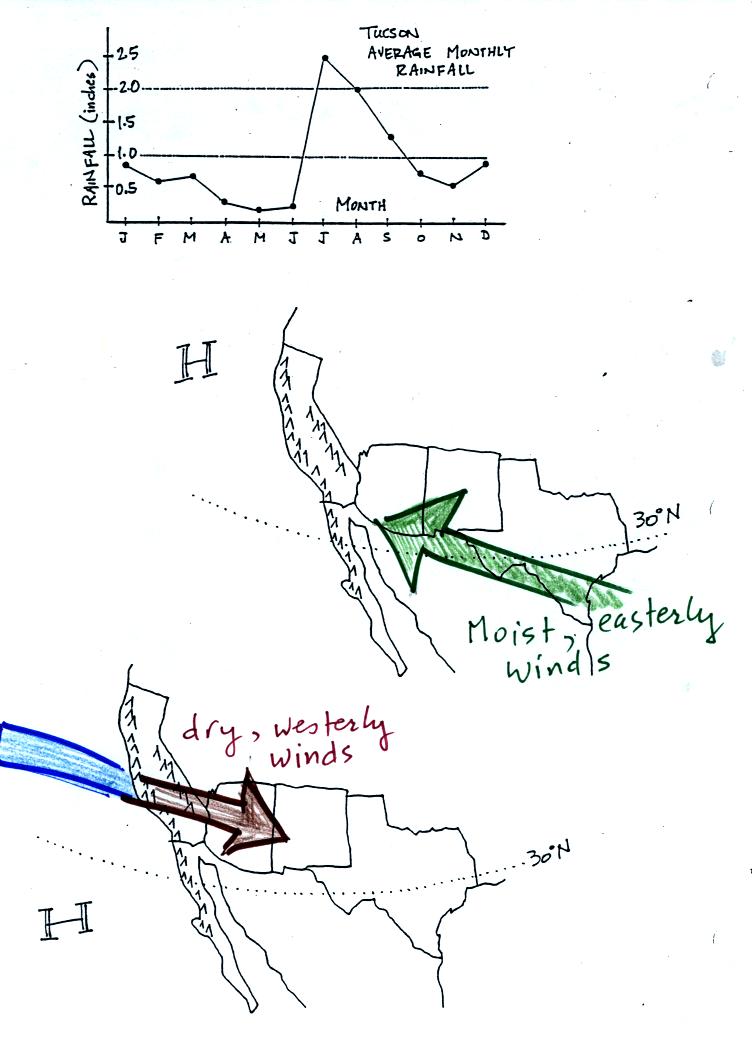
In the
winter the subtropical high moves south of 30 N latitude (bottom part
of the figure above).
Winds to the north of the high blow from the west. Air
originating over the Pacific Ocean loses much of its moisture as it
crosses mountains in California (remember the rain shadow
effect). The air is pretty dry by the time it reaches
Arizona. Significant winter rains occur in Arizona when storms
systems are able to draw moist subtropical air from the southwest
Pacific ocean into
Arizona.
Normally about half Tucson's yearly rainfall (about 12 inches per year)
comes during
the 2 or 3 month long "summer monsoon" season. The word monsoon
refers to a
seasonal change in wind direction (it is often used incorrectly by
people in Tucson to refer to thunderstorms). During the summer
subtropical
high pressure (the Pacific high) moves north of its normal position
near 30 N
latitude. Winds on the southhern side of the subtropical high
have an easterly component. Moist air originating in Mexico
and the Gulf of Mexico blows into Arizona. The sun heats the
ground during the day, warm moist air in contact with the ground rises
and
produces convective thunderstorms.
The close proximity of the Pacific
high, with its sinking air motions,
is what gives California, Oregon, and Washington dry summers.
The term monsoon
means a shift (seasonal shift)
in the direction of the prevailing winds
We reviewed the events covered in class on Friday that lead up to the
formation of a thunderstorm. This is summarized more concisely in
the figure below. it takes some
effort and often a good
part of the
day before a thunderstorm forms. The air must be lifted to just
above the
level of free convection. Once air is lifted above the level of
free
convection it finds itself warmer and less dense that the air around it
and
floats upward on its own. The is the
moment at
which the air mass thunderstorm begins.
This was followed by
a time lapse video tape of
actual thunderstorm formation and growth.
Once a
thunderstorm develops it then goes through 3 stages.

In the
first stage you would only find updrafts inside the cloud (that's all
you need to know about this stage, you don't even need to remember its
name).

Once precipitation has formed and grown to a certain size, it will
begin to
fall and drag air downward with it. This is the beginning of the
mature
stage where you find both an updraft and a downdraft inside the
cloud.
The falling precipitation will also pull in dry air from outside the
thunderstorm (this is called entrainment). Precipitation will mix
with
this drier air and evaporate. The evaporation will strengthen the
downdraft
(the evaporation cools the air and makes it more
dense).
The thunderstorm is strongest in the mature stage. This is when
the
heaviest rain, strongest winds, and most of the lightning occur.
Eventually the downdraft spreads
horizontally throughout the inside of
the
cloud and begins to interfere with the updraft. This marks the
beginning of the end for this thunderstorm.

The
downdraft eventually fills the interior of the cloud. In this is
the dissipating stage you would only find weak downodrafts
throughout the cloud.
Note how the winds from one
thunderstorm can cause a region of
convergence on
one side of the original storm and can lead to the development of new
storms. Preexisting winds refers to winds that were blowing
before the
thunderstorm formed. Convergence between the prexisting and the
thunderstorm downdraft winds creates rising air that can initiate a new
thunderstorm.
The
picture below shows some of the features at the base of a thunderstorm.
The cold downdraft air spilling out of
a
thunderstorm hits the ground
and
begins to move outward from underneather
the
thunderstorm. The leading edge of this outward moving air is
called a
gust front. You can think of it as a dust front because the gust
front
winds often stir up a lot of dust here in the desert southwest (see
below).
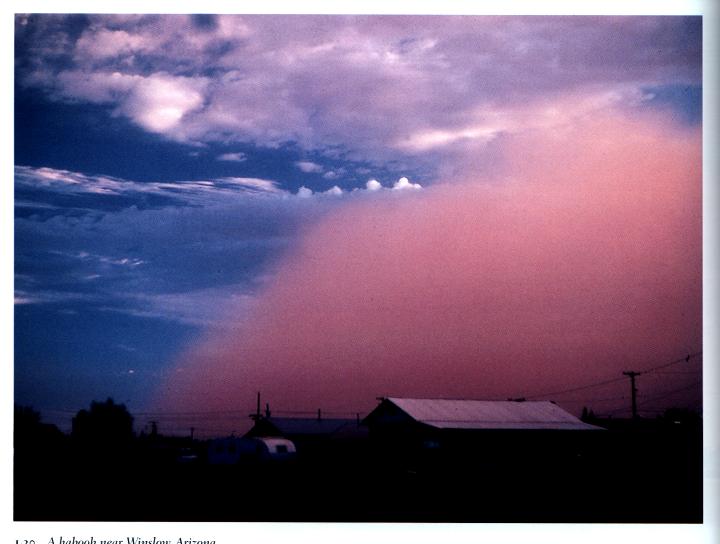
The
gust front in this picture (taken
near Winslow, Az) is moving from the right
to the
left. Visibility in the dust cloud can drop to near zero which
makes this
a serious hazard to automobile traffic. Dust storms like this are
sometimes called "haboobs".
The following picture shows a shelf
cloud.
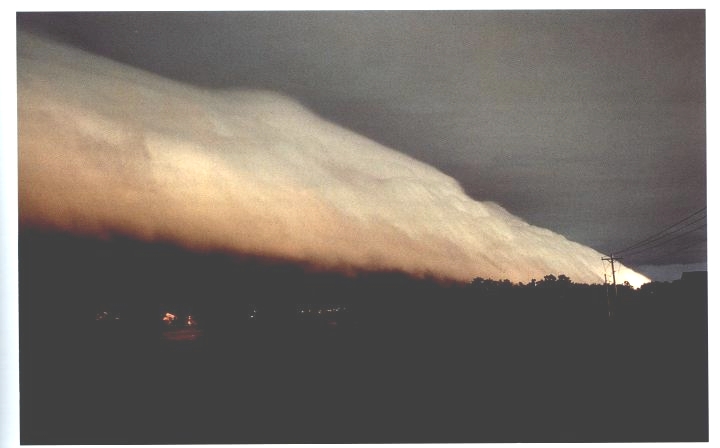
Warm
moist air if lifted by the cold air behind the gust front which is
moving from left
to right in this picture. The shelf cloud is very close to the
ground, so
the warm air must have been very
moist because it didn't have to rise and cool much before it became
saturated and a
cloud
formed.
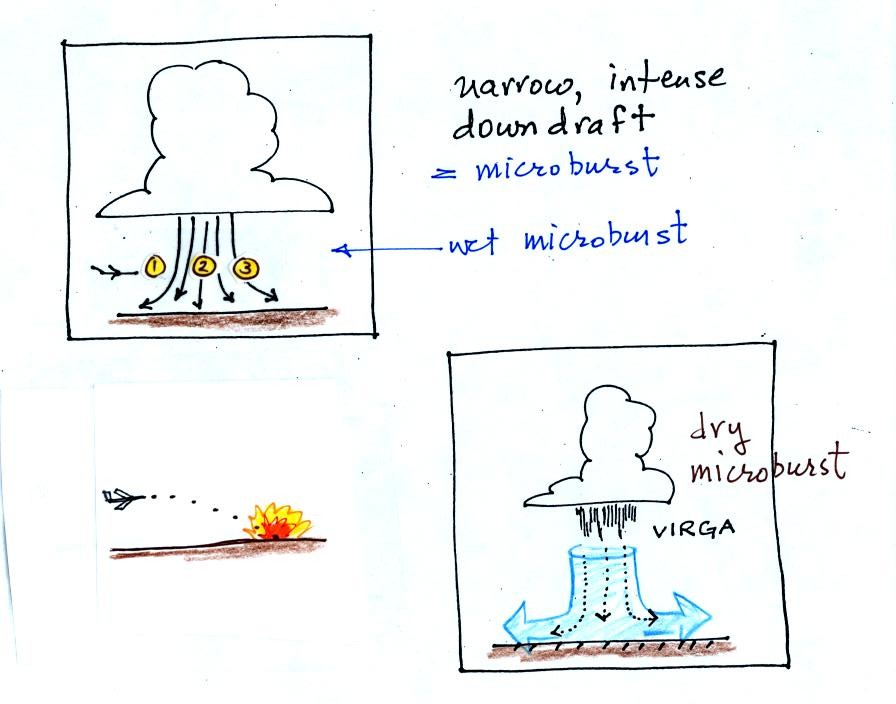
A
narrow intense downdraft is called a microburst. At the ground
microburst winds will sometimes reach 100 MPH (over a limited area);
most
tornadoes have winds of 100 MPH or less. Microburst winds can
damage
homes (especially mobile homes that aren't tied to the ground), uproot
trees,
and seem to blow over a line of electric power poles at some point
every summer
in Tucson.
Microbursts
are a serious threat to
aircraft
especially when they are close to the ground during landing or
takeoff.
An inattentive pilot encountering headwinds at Point 1 might cut back
on the
power. Very quickly the plane would lose the headwinds (Point 2)
and then
encounter tailwinds (Point 3). The plane might lose altitude so
quickly
that it would crash into the ground before corrective action could be
taken.
Falling rain could warn of a (wet)
microburst. In other cases,
dangerous
dry microburst winds might be invisible (the virga,
evaporating
rain,
will
cool
the air, make the air more dense, and
strengthen
the downdraft winds).
A simple demonstration can give you an
idea of what a microburst might
look
like.

A large plastic
tank was filled
with water, the water represents air in the
atmosphere. Then a colored mixture of water and glycerin, which
is a
little denser than water, is poured into the tank. This
represents the
cold dense air in a thunderstorm downdraft. The colored liquid
sinks to
the bottom of the tank and then spreads out horizontally. In the
atmosphere the cold downdraft air hits the ground and spreads out
horizontally. These are the strong winds that can reach 100 MPH.

Here's
a picture of a wet microburst, a narrow intense thunderstorm downdraft
and
rain.
Here are a couple of videos from YouTube. The first
video shows a microburst from some distance away. The second video was
taken in the heavy rain and strong winds under a thunderstorm in the
microburst.
We'll have a quick look at severe thunderstorms and supercell
thunderstorms in class on Wednesday.



